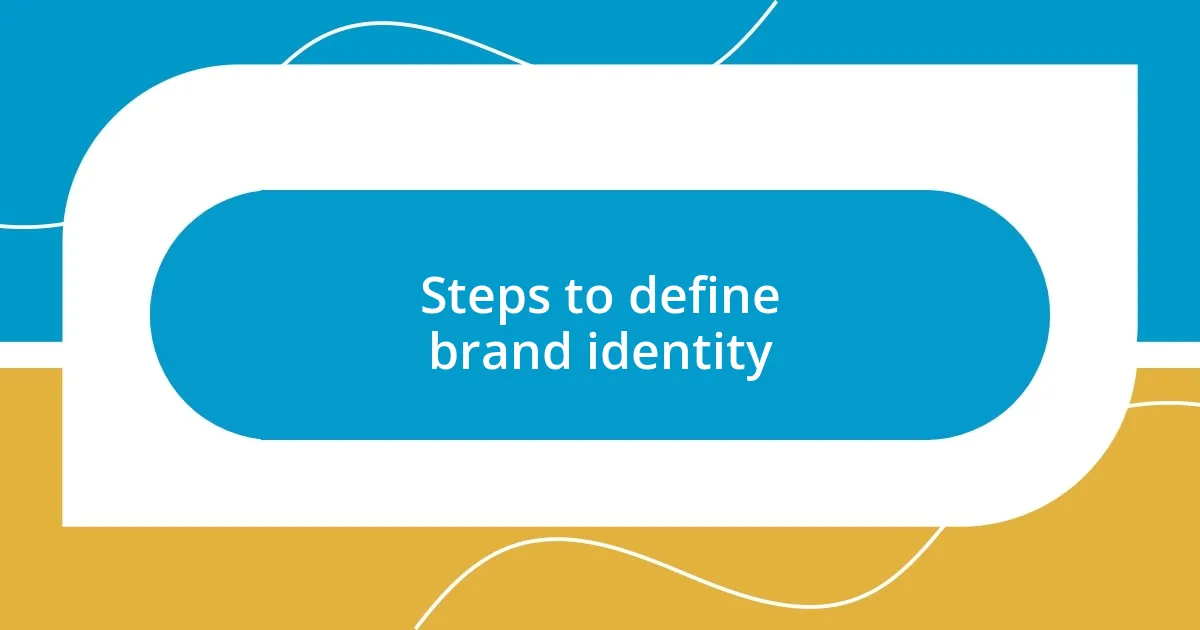Key takeaways:
- Brand guidelines create a cohesive brand identity, ensuring consistency in messaging and visuals, which fosters audience trust and loyalty.
- Defining brand identity involves understanding core values, researching target audiences, and establishing visual elements like logos and color palettes.
- Documenting brand guidelines is essential for clarity and consistency; it should include visual examples and be regularly updated to reflect brand evolution.
- Implementing and maintaining brand guidelines requires ongoing commitment, team involvement, and proactive monitoring to avoid inconsistencies.

Understanding brand guidelines
Brand guidelines are essential because they serve as the visual and verbal framework for a brand’s identity. When I first started developing my own brand guidelines, I realized it wasn’t just about pretty fonts or colors; it was about crafting a cohesive story that resonates with the audience. Have you ever noticed how certain brands can spark an emotional connection just through their consistent use of colors and messaging? That’s the magic of well-defined guidelines.
To me, brand guidelines are like a protective shield—they ensure that every piece of communication reflects the same essence of the brand. I remember a time when I saw a brand’s social media post that completely contradicted its main messages. It was jarring. It made me wonder: how could this happen? With clear guidelines in place, such inconsistencies can be avoided, allowing the brand’s voice to shine through in every interaction.
When you create brand guidelines, think of it as giving your brand a personality. It’s about defining who you are and how you want to be perceived. A friend once told me that having explicit guidelines helped her team stay aligned during brainstorming sessions. Instead of swaying in different directions, everyone knew exactly what the brand stood for, which made the creative process so much smoother. Isn’t it fascinating how something seemingly simple can lead to deeper connections with your audience?

Importance of brand consistency
Brand consistency is crucial for establishing trust with your audience. I’ve often found that when I come across a brand that feels genuine and cohesive, it gives me a sense of security, like they know what they’re doing. For instance, I once followed a small business that had a beautiful website, but their Instagram feed was disjointed and chaotic. It left me confused about their offerings and ultimately made me lose interest.
Maintaining a consistent brand identity fosters recognition and loyalty. Here’s why it matters:
- Easier Recognition: Consistency helps the audience identify and remember your brand.
- Builds Trust: A unified voice and appearance instill confidence in potential customers.
- Enhances Credibility: A cohesive brand image reflects professionalism, making your brand more credible.
- Encourages Loyalty: People are more likely to stick with brands they recognize and trust over time.
- Facilitates Marketing Efforts: Marketing becomes streamlined when the brand’s voice and visuals are consistent, allowing for more effective campaigns.
I’ve noticed that when my materials align with my brand guidelines, I not only feel proud but see a tangible increase in engagement. It’s like having a warm conversation with an old friend rather than meeting someone new; there’s a comforting familiarity that builds connection.

Steps to define brand identity
Defining your brand identity involves a series of intentional steps that ultimately lead to a clear and resonant representation of who you are. The first step is to understand your core values. What do you stand for? I recall when I sat down to pinpoint my own values—it felt like peeling back layers of an onion, revealing the essence of what truly mattered to me. This clarity not only shaped my brand’s messaging but also aligned my actions with its identity.
Next, I recommend researching your target audience. Who are they, and what do they care about? I remember conducting surveys and gathering feedback that opened my eyes to my audience’s preferences and pain points. That feedback loop fueled my creativity and helped ensure that every aspect of my brand felt relevant and engaging to them.
Finally, visually identifying your brand through elements like logo, color palette, and typography is crucial. Each choice you make should echo the personality you’ve defined. I learned this firsthand when I redesigned my logo. It wasn’t just about aesthetics; it was about ensuring every visual spoke the same language as my messaging. It was rewarding to see how even the smallest visual shift could enhance the overall perception of my brand.
| Step | Description |
|---|---|
| Identify Core Values | Understand what principles are at the heart of your brand. |
| Research Target Audience | Gather insights into the needs and preferences of your audience. |
| Define Visual Elements | Choose logo, colors, and typography that reflect your brand’s personality. |

Establishing brand voice and tone
Establishing your brand’s voice and tone is like finding the perfect way to express yourself. I realized firsthand how tone can shift perceptions when I experimented with my social media posts. During one campaign, I tried a friendly, conversational tone, and the engagement skyrocketed. It made me think—how often do we underestimate the power of words in connecting with our audience?
In crafting a voice that resonates, it’s essential to consider who you’re speaking to. I often ask myself, “What would my ideal customer respond to?” Understanding that audience transforms my writing, making it more relatable. For example, I started infusing humor into my newsletters, and the warm responses reminded me that people enjoy a human touch—this is how relationships are built.
Moreover, consistency in voice is just as vital as consistency in visuals. When I decided to maintain a particular tone across all platforms, I noticed that my brand identity became stronger. People began recognizing my posts in their feeds without even needing to see my logo. Have you ever felt a brand’s voice was so familiar that it felt like a friend speaking to you? That’s the feeling I aim to create, and it starts with finding the right voice that reflects both my values and resonates with my audience.

Documenting the brand guidelines
Documenting brand guidelines is a pivotal step in ensuring a cohesive representation of your brand. When I sat down to create my own brand book, I realized it wasn’t just about putting words on paper; it was about crafting a roadmap for anyone who would engage with my brand. Each section—from logo usage to color specifications—was a chance for me to define how my brand would be perceived consistently across all channels. That clarity brought a deep sense of satisfaction.
To make the guidelines truly useful, I also included visual examples and practical dos and don’ts. I remember spending hours selecting visuals that exemplified the proper use of my logo, and that effort paid off immensely. This hands-on approach made it easier for collaborators, designers, and anyone else representing my brand to grasp the essence of what I wanted to convey. Have you ever attempted to explain something without visuals? It can be confusing, right? By incorporating visuals, I created a reference that felt both accessible and engaging.
Lastly, I emphasize the importance of updating brand guidelines as your brand evolves. I learned that holding onto outdated elements can lead to mixed messages. When I updated my guidelines after a significant rebranding, it was liberating to see how my new direction was reflected in every facet of the document. The change made me ask myself, “How does my brand need to grow to stay relevant?” Keeping the guidelines dynamic encourages growth and connection, ensuring the brand stays fresh and resonant with its audience.

Implementing and maintaining guidelines
Implementing and maintaining brand guidelines isn’t merely about having a document filed away—it’s an ongoing commitment. I remember the early days when I overlooked the need for regular check-ins. The moment I started holding quarterly reviews, I noticed how much easier it became to ensure every marketing piece truly represented my brand’s ethos. It’s amazing what a simple habit like that can achieve—have you ever found clarity in routine practices?
A vital part of sustaining these guidelines is involving the entire team. I learned this when I conducted a workshop where I invited team members from various departments to discuss the brand principles. The energy in the room was infectious! Everyone shared ideas and experiences, which made them feel deeply connected to the brand’s mission. This collaborative spirit not only solidified their understanding but also sparked fresh directions I hadn’t considered. How often do brands find new insights by just listening to their own people?
Consistency, once established, doesn’t just happen—it’s actively nurtured. I discovered a valuable lesson through social media monitoring; it’s critical to catch inconsistencies early. During one campaign, I noticed mixed messaging on a few platforms that didn’t align with our guidelines. It became clear we needed proactive monitoring, and so I set up alerts and reminders for my team. Now, any deviation is quickly addressed, allowing our brand’s story to remain cohesive. Have you ever felt frustrated by mixed messages from a brand? That’s the type of disconnect I’m determined to avoid.














